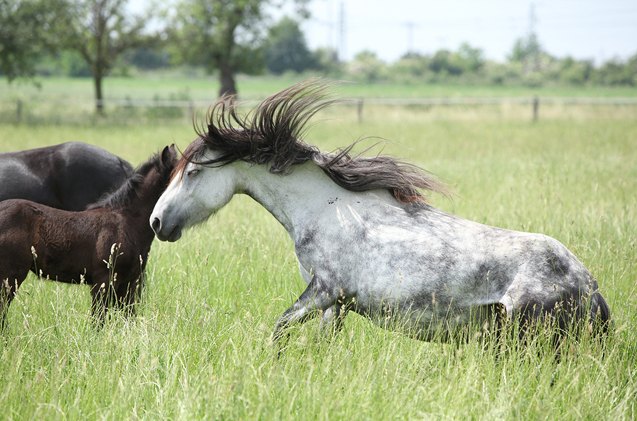Fell Pony


About Fell Pony
The Fell Pony is an equine breed that is native to England, particularly in the north and mostly in Cumbria, and it was bred originally on northwest England’s fell farms. It is believed that this is probably where the ponies roamed even during pre-historic times.
In Britain, by the time of the Iron Age, horses were commonly used in a variety of ways every day. The ponies, in particular, averaged 12.1 hands high, and in terms of their overall build, they looked a lot like the Exmoor equine breed. Later, the average height of the ponies in Britain increased to about 13 hands high.
Fell ponies prefer to engage in activities that stimulate their curiosity.
Fell ponies were also used by the Vikings for work and riding, and these horses were kept in villages, while the breeding stock lived on the fell. During the 11th and 12th centuries, these ponies were utilized for various purposes, and by the 13th century, they were utilized to transport products throughout the country.
The Fell Pony became increasingly popular because it was fast, a steady walker, and strong, but it was also small enough that it could be loaded easily. As industrialization continued, these ponies were used to transport a variety of goods, and the Fell Pony was used until the 20th century for moving machinery above ground and in mines underground.
By the latter part of the 19th century, pony breeders started to record pedigrees. It was not until 1898 that the first Fell ponies were registered as part of the Polo and Riding Pony Stud Book. To keep the old pony breed pure, the Fell Pony Society was established in 1922, especially because cross breeding was occurring.
Today, the popularity of the Fell Pony breed continues to increase, and the number of the ponies that are registered has steadily risen in the first 10 years of the 21st century alone.
The Fell Pony is a popular breed because it has an attractive temperament that is similar to other native pony breeds from Britain.
These ponies have a strong survival instinct, and they are curious, intelligent, and mischievous. However, it is important to understand that every Fell Pony will have its own temperament, as they are all individuals with unique personalities.
These ponies prefer to engage in activities that will stimulate their curiosity and their mind, so they enjoy having a job to do. Sensible training is required, but you need to create a partnership, or a cooperative relationship, with your pony for the best results.
Children and small adults can ride these ponies, and they have an easy and comfortable gait.
Fell ponies were used by the Vikings.
The Fell Pony features a head that is chiseled and small, with a broad forehead and tapering to the nose. The nostrils are large, the ears are well formed, small, and neatly set, and the eyes are bright, intelligent, mild, and prominent. This pony’s neck is of a proportionate length with the rest of the body, and it is strong but not too heavy.
You will also note that the pony’s shoulders are sloping, well laid back, and muscular. The hind legs are notably muscular, and the hocks are clean cut. The hooves are of a good size, well formed, and round. There is a lot of fine hair at the heels, and the tail and mane are allowed to grow bushy, thick, and long.
Children and small adults can ride Fell ponies.
The Fell Pony breed features several colors. These include brown, black, gray, pale gray, bay, and chestnut. White markings, such as a small amount of white on the hind pasterns, as well as white stars, are also possible on the Fell Pony’s coat. However, over 50% of the population of this breed does not have any white markings.
In the second half of the 1900s, the predominant color of the breed was black. This was followed by brown, bay, and gray.
Regular grooming sessions are necessary to keep a Fell Pony’s coat looking clean, smooth, and healthy. Extra attention needs to be paid to the tail and the mane, which are thick and long. Adequate washing and grooming will keep these clean and detangled, especially when using the appropriate tail and mane brushes.
You should also be sure to clean the hooves carefully with a hoof pick and observe for any conditions that may be developing there. And you need to keep the hair around the hooves clean and healthy, too.
For the rest of the body, you can remove debris, loose hair, and dirt from your pony’s coat by using a curry comb, as well as a dandy brush and a shedding blade. A body finishing brush is best used on sensitive areas, such as the legs and face. Using these standard equine grooming tools will give you the chance to spend time with your pony and bond with your animal, which is important for this breed.
Photo credit: Zuzule/Bigstock

Lisa Selvaggio is a freelance writer and editor, and our resident cats-pert, with certifications in pet nutrition and pet first aid. She enjoys producing content that helps people understand animals better so they can give their pets a safe and happy home.
More by Lisa Selvaggio

























